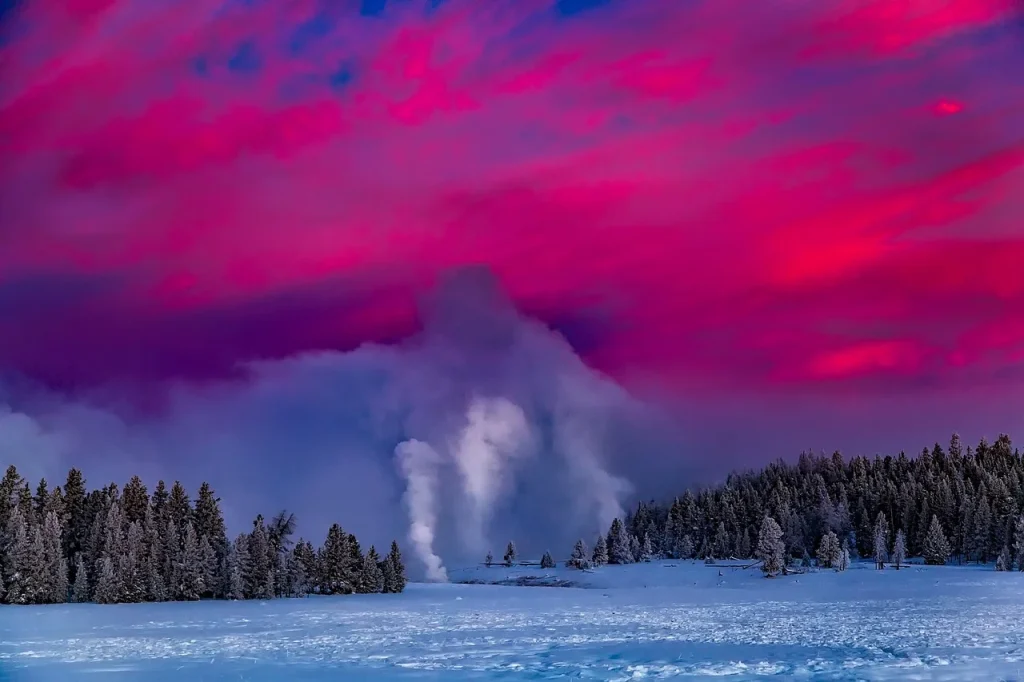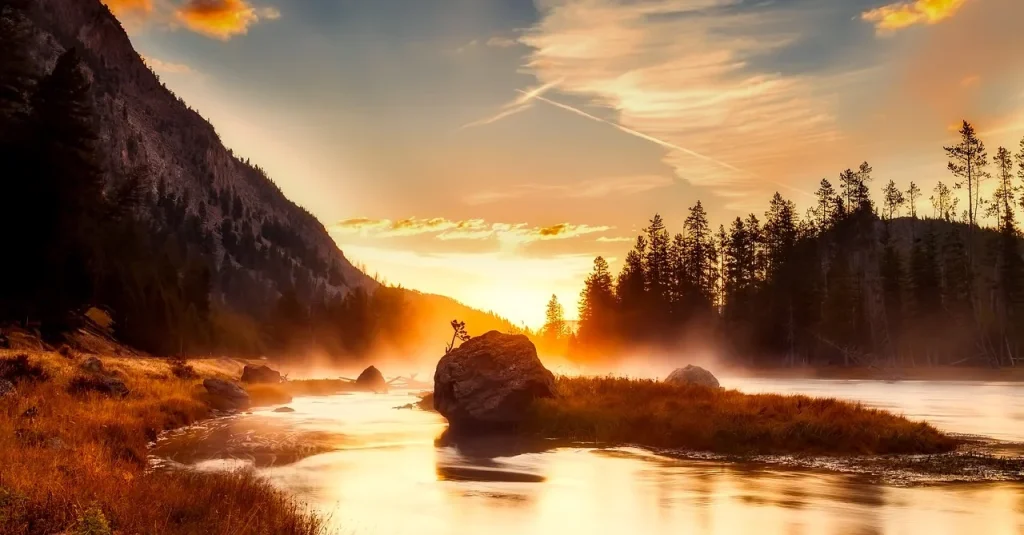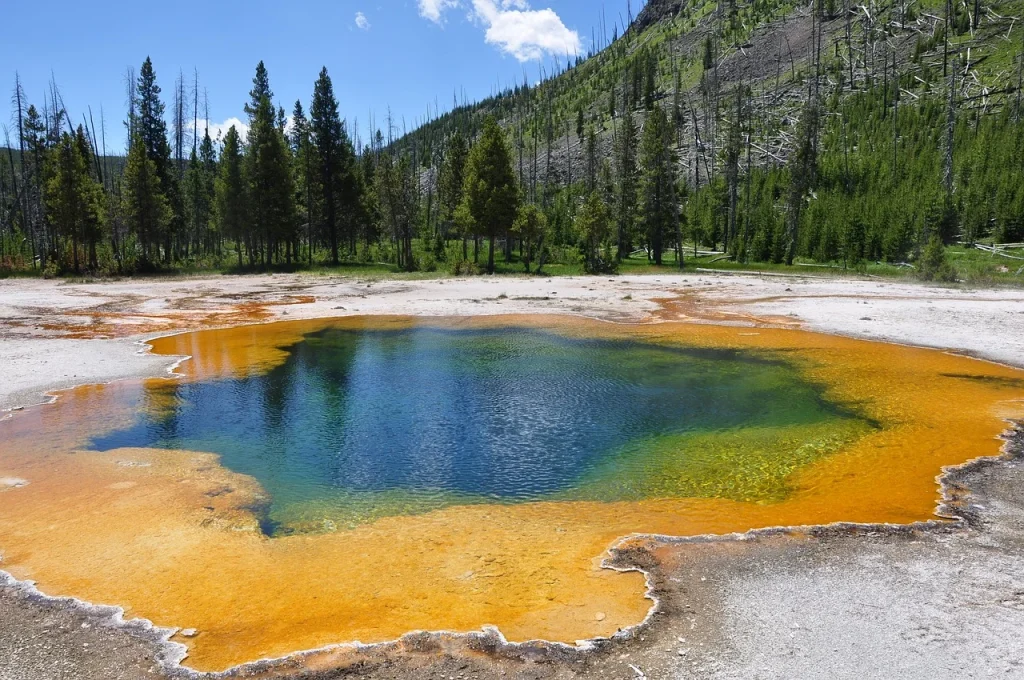Step into Yellowstone National Park, a place where geysers erupt, waterfalls cascade, and wildlife roams free. Have you ever been curious about the mysteries this park holds? With its rich geological features and diverse habitats, Yellowstone is a living museum of natural history.
In this article, we’ll share some incredible facts about this iconic park, each one showcasing why Yellowstone continues to enchant visitors from around the world. Whether you’re a first-time visitor or a seasoned explorer, these facts will deepen your appreciation for the park’s beauty and significance.
Yellowstone, of all the national parks, is the wildest and most universal in its appeal.
David Attenborough
Yellowstone National Park Facts
Let’s start our journey through the exploration of Yellowstone National Park. Make sure you pay close attention to each fact, as a quiz at the end will challenge your expertise on the topic.
- The park’s supervolcano has the capability to erupt with a force over 1,000 times greater than the Mount St. Helens eruption in 1980.
- Hidden beneath the surface, the magma chamber is approximately 40 to 150 miles in size, making it one of the largest on Earth.
- The Steamboat Geyser, the world’s tallest currently-active geyser, can eject boiling water up to 300 feet in the air.
- The park is home to more than 10,000 hydrothermal features, including geysers, hot springs, mudpots, and fumaroles.
- Over half of the world’s geysers are preserved here, making it the most concentrated area of geysers globally.
- Yellowstone Lake is one of the highest altitude lakes in North America, resting at 7,733 feet above sea level.
- This area experiences approximately 1,000 to 3,000 earthquakes annually, making it one of the most seismically active regions in the United States.
- The park was established in 1872, making it the first national park in the world, even predating the National Park Service itself.
- Lamar Valley is often called the “Serengeti of North America” for its large and easy-to-spot populations of large mammals.
- The park’s petrified forests, among the largest in the world, consist of fossilized trees that became mineralized over millions of years.
- Yellowstone Caldera is nicknamed the “sleeping giant” due to its massive potential energy.
- The Grand Prismatic Spring is larger than a football field and is notable for its vivid colors, which stem from microbial mats around the edges.
- Old Faithful, arguably the park’s most famous geyser, erupts every 44 to 125 minutes.

- The park spans over 2.2 million acres, making it larger than the states of Delaware and Rhode Island combined.
- The Native American presence in the region dates back more than 11,000 years.
- Yellowstone is part of the Greater Yellowstone Ecosystem, one of the largest nearly-intact temperate-zone ecosystems on Earth.
- The park’s diverse ecosystem supports the presence of all native carnivore species, including wolves, which were successfully reintroduced in the 1990s.
- Grizzly bears in the park can gain up to 3 pounds per day before hibernation.
- The Continental Divide runs through the park, directing water to both the Atlantic and Pacific Oceans.
- Trout Lake is renowned for its high visibility and abundance of cutthroat trout, making it a popular spot for anglers.
- The Firehole River is heated by the thermal features, allowing for swimming even when the surrounding areas are covered in snow.
- Black Dragon’s Cauldron is a mudpot that formed suddenly in 1948, spewing mud up to 40 feet into the air during its initial eruption.
- The park’s vast wilderness is accessible through over 900 miles of hiking trails.
- Isle Royale in Yellowstone Lake features the park’s largest concentration of wilderness geysers.
- Obsidian Cliff was a key source of raw materials for prehistoric Native American tools, and was extensively traded across the continent.
- The park’s winter ecosystem is crucial for the survival of the endangered Canada lynx, which depends on the cold, snowy environment.
- The park holds the Fort Yellowstone Historic District, which includes buildings that are over 100 years old and reflect early conservation efforts.
- Yellowstone’s ecosystem is critical for studying ecological processes due to its uninterrupted natural laboratory.

- The park is a significant birding destination, with over 300 bird species recorded.
- Yellowstone’s volcanic activity produces enough heat to power the entire country if it could be harnessed effectively.
- The Yellowstone River is the longest undammed river in the contiguous United States, flowing freely for over 670 miles.
- Roosevelt Arch at the North Entrance was dedicated by President Theodore Roosevelt and bears the inscription “For the benefit and enjoyment of the people.”
- Hayden Valley was once a lakebed and is now a central location for viewing wildlife like bison and elk.
- The park’s vast forest is a significant carbon sink, helping to absorb carbon dioxide from the atmosphere.
- Thermal areas are constantly changing with new springs appearing and old ones closing up due to the shifting underground hydrothermal systems.
- Norris Geyser Basin is the hottest and most changeable thermal area in the park.
- During the harsh winters, the park’s bison use their heavy heads like a snowplow to clear snow and access the grass underneath.
- The Museum of the National Park Ranger is located here, showcasing the history and traditions of park rangers across the United States.

- Artist Point offers one of the most iconic views of the Lower Falls of the Yellowstone River, a spot famously painted and photographed through the years.
- The park has a dedicated scientific research station which focuses on studying the unique geothermal biology and geology of the area.
- Thermal features are so acidic in some areas that they can dissolve metal, emphasizing the need for cautious exploration.
- The park’s altitude ranges from 5,282 to 11,358 feet, offering diverse habitats and weather patterns.
- It has a Historic Preservation Team dedicated to maintaining its hundreds of historical structures.
- Lake trout, an invasive species, threaten the native cutthroat trout population, leading to ongoing management efforts to control their numbers.
- The park’s incredible biodiversity includes rare plant species that are found nowhere else on earth.
- The Canyon Village area showcases some of the park’s most breathtaking rock formations and deep canyons.
- The park is one of the few places in the U.S. where you can see steam vents (fumaroles) that release volcanic gases directly into the air.
- Over 52 species of mammals have adapted to survive the harsh and varying climates within the park’s boundaries.
- The Bechler region of the park is often referred to as “Cascade Corner” due to its numerous waterfalls and relatively lush vegetation.
- Yellowstone’s volcano is fueled by a hotspot under the North American tectonic plate, a rare geological phenomenon.
Yellowstone National Park Myths

Now that we’ve covered the facts, it’s time to separate truth from myth. Let’s read some common misconceptions and set the record straight.
- Yellowstone is named after yellow rocks in the park.
It was actually named after the Yellowstone River, which got its name from the yellowish sandstone bluffs found along its banks. These bluffs were noticed by Native American tribes and early European explorers. - Old Faithful erupts every hour on the hour.
Old Faithful’s eruptions are not exactly hourly. The intervals between eruptions range from 35 to 120 minutes. Predictions are made based on the duration and characteristics of the previous eruption. - Yellowstone is closed during winter.
While some roads and facilities are closed, it remains open year-round. Winter visitors can enjoy activities such as snowshoeing, cross-country skiing, and snowmobile tours, offering a unique way to experience the park’s beauty. - All the geysers in Yellowstone are predictable.
Only a few geysers, like Old Faithful, have predictable eruption times. Most of Yellowstone’s geysers are irregular and unpredictable, making each visit to the park a unique experience with different geysers active at different times. - Yellowstone is just a volcano waiting to erupt.
While it is a supervolcano, it is not on the brink of erupting. Scientists continuously monitor the park for signs of volcanic activity, and no imminent threat has been detected. Visitors can safely enjoy the park’s natural wonders.
No products found.
Yellowstone National Park Quotes

We continue to the next section. Here you will find some of my favorite quotes. Feel free to share yours in the comments so I can add them to the list as well.
In Yellowstone, we have a very special place that holds the spirit of the great outdoors.
Dan Quayle
Former Vice President Dan Quayle captures the essence of Yellowstone’s unique and invigorating outdoor spirit.
To put it mildly, the park is something of a geologic freak.
John Wesley Powell
Explorer and geologist John Wesley Powell marvels at Yellowstone’s unique and unusual geological features.
There is no place more delightful in all of America.
Theodore Roosevelt
President Theodore Roosevelt extols the unparalleled delight and beauty of Yellowstone National Park.
The Yellowstone Park is something absolutely unique in the world, as far as I know.
Rudyard Kipling
Renowned author Rudyard Kipling highlights the singular and unparalleled nature of Yellowstone.
Yellowstone is a wonderland, a mirror held up to nature’s majesty.
Susan B. Anthony
Activist Susan B. Anthony reflects on Yellowstone as a majestic representation of nature’s splendor.
Yellowstone National Park FAQ

Before the quiz, we are approaching the FAQ section. Read carefully if you want to score a perfect ten.
- How was Yellowstone Park formed?
It was primarily formed due to volcanic activities. The park sits atop a volcanic hotspot where light, hot, molten rock rises towards the surface, creating geothermal features like geysers and hot springs. Its landscape is continuously shaped by the underlying volcanic forces. - What state is Yellowstone Park located in?
It is uniquely spread across three states: primarily in Wyoming, but with parts extending into Montana and Idaho. Most of the park, however, is in Wyoming. - Which airport is best to get to Yellowstone Park?
The best airport for Yellowstone depends on your itinerary. Bozeman Yellowstone International Airport in Montana is a popular choice for its good connectivity and proximity to the park’s north and west entrances. - What is the best time of year to visit Yellowstone?
The best time to visit it is from late April through May or from September to October. These months offer milder weather, fewer crowds, and great opportunities for wildlife viewing. - Can you stay overnight in Yellowstone National Park?
Yes, it offers a variety of accommodations, including lodges and hotels inside the park, as well as numerous campgrounds. Advance reservations are highly recommended, especially during peak tourist seasons.
No products found.
Yellowstone National Park Trivia

Welcome to our Yellowstone Park quiz! Strap in and get ready to rumble with geysers and grizzlies. Warning: score zero, and you might just find yourself volunteering as the next park mascot!
Conclusion
From the steaming geysers to the roaming wildlife, Yellowstone Park serves as a reminder of the wild beauty that once covered much of the Earth. It’s a place that inspires and awes, urging us to reflect on our role in nature.
As we leave the park, let’s carry its lessons and memories with us. Till next time, stay curious and explore more. Cheers.
8 Sources Used For This ArticleAmerica’s First National Park – Fly Line Images
Yellowstone at 152 years old – Fox News
Places in Yellowstone – Nps
Things You Didn’t Know About America’s Oldest National Park – Cheapism
What Is The Greater Yellowstone Ecosystem – Gye Wild
Yellowstone National Park – New World Encyclopedia
Fascinating Facts About Yellowstone National Park – Nat Hab


